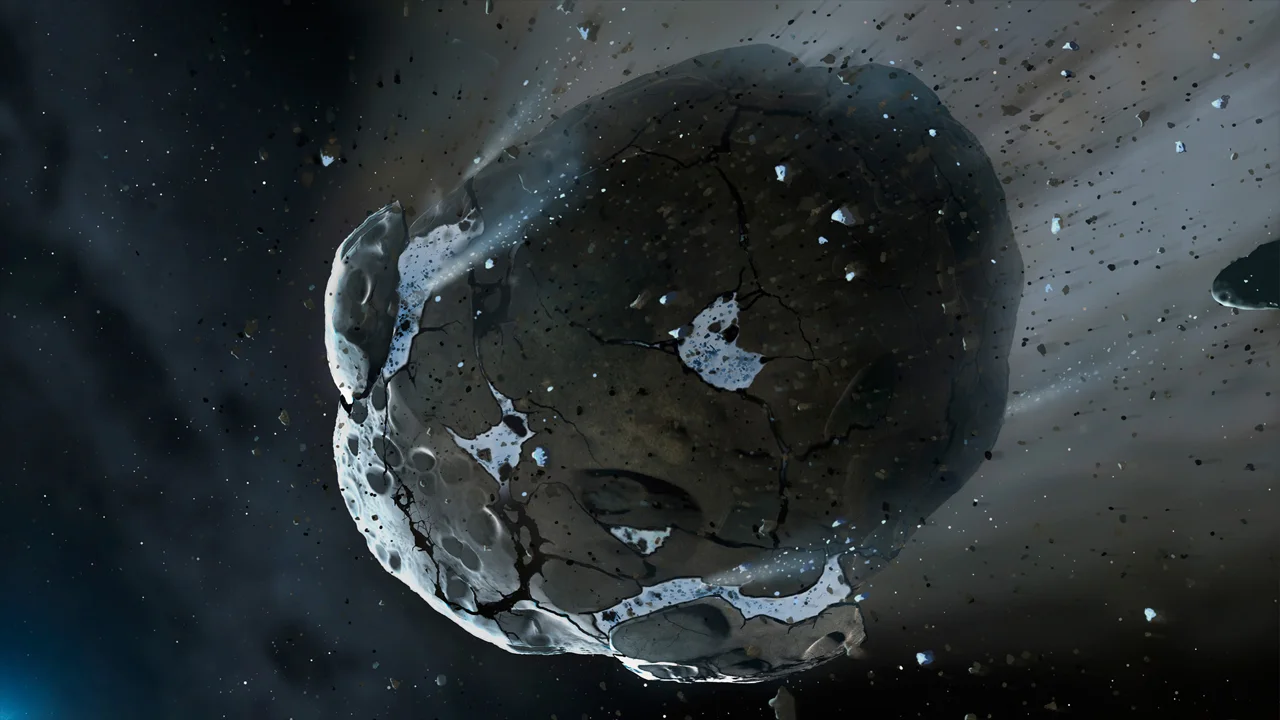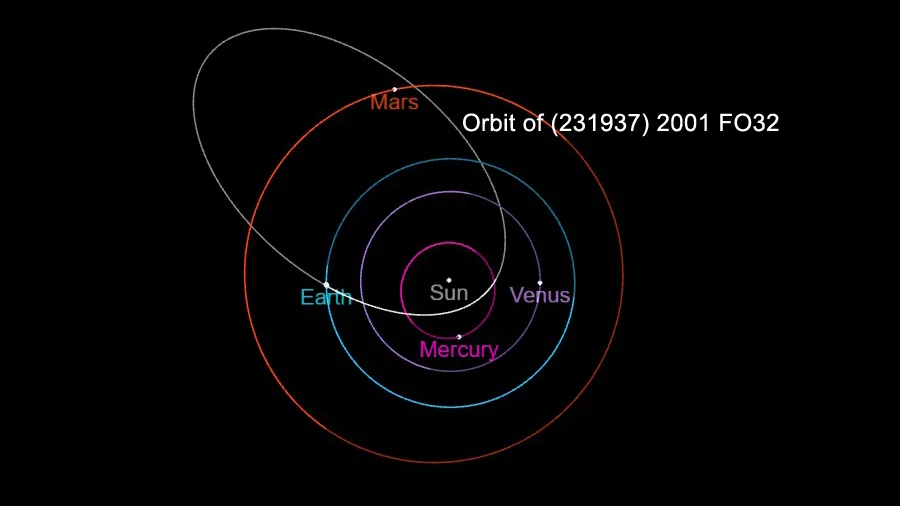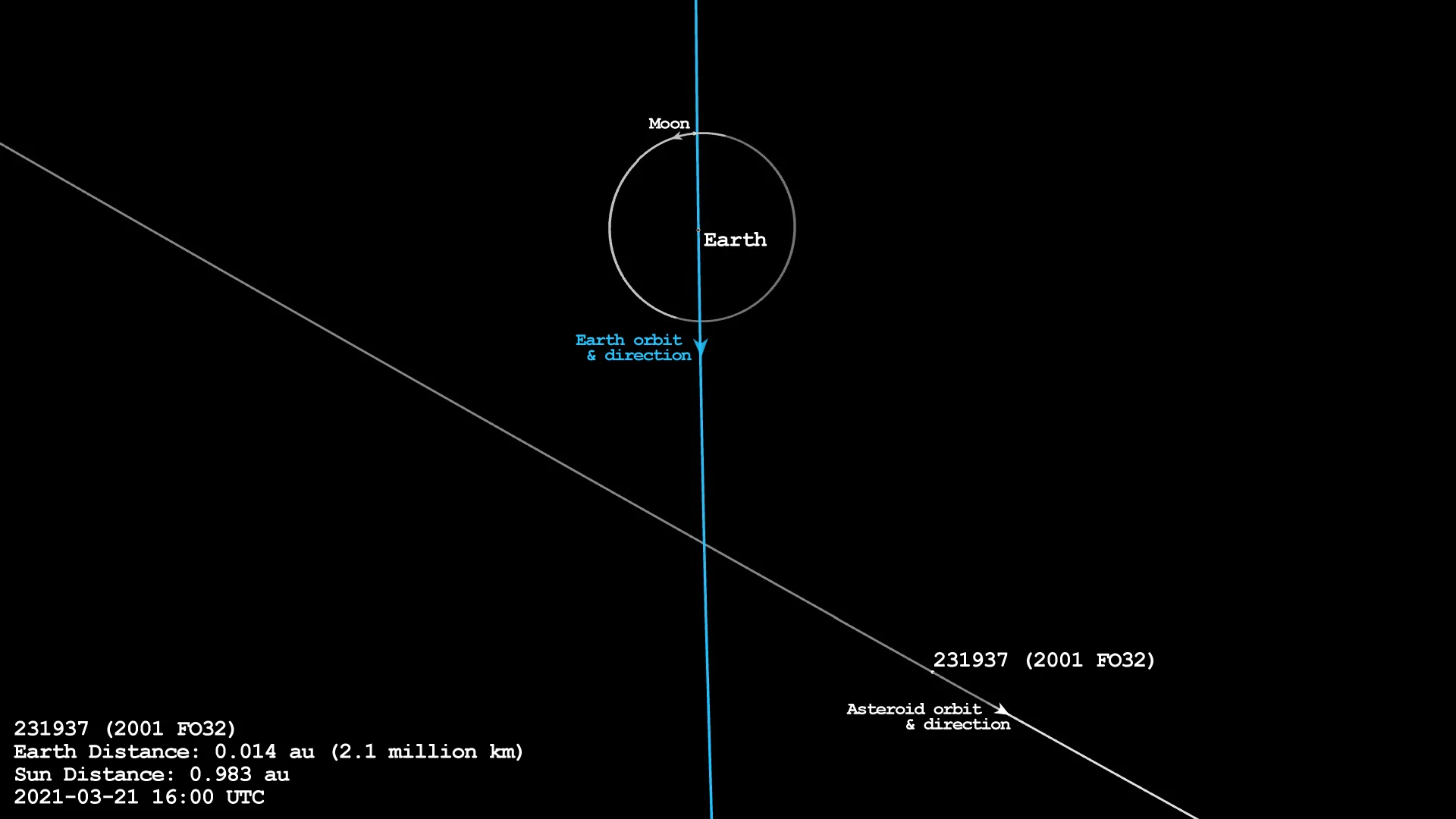
Biggest, fastest known asteroid of 2021 swings by on Sunday
NASA says there is no threat of a collision with our planet now or for centuries to come.
A massive asteroid, at least as big as the CN Tower, is making a flyby of Earth on March 21. We've known about this kilometre-wide space rock for nearly 20 years, and its upcoming encounter the largest and fastest flyby for any known asteroid in all of 2021.
According to NASA's Center for Near-Earth Object Studies (CNEOS), nearly one hundred known asteroids are set to fly past Earth before the end of 2021. Among these, one in particular — (231937) 2001 FO32 — stands out from the rest in two ways.
At an estimated 1.1 kilometres wide, it is the largest known asteroid to fly past us this year. It could possibly be up to 1.7 km wide, based on astronomical records from over the past two decades. However, NASA says that recent observations from their infrared NEOWISE satellite suggest that it is closer to 560 metres meters wide. Based on previous discoveries, the differences in these estimates could simply be due to having better instruments at our disposal to measure the asteroid's size. However, it could also indicate that 2001 FO32 is a potato-shaped space rock, and thus longer
Of the approximately 25,000 near-Earth asteroids that we know about, only around 20 per cent are larger than 300 metres. This drops to just 3.5 per cent for asteroids larger than one kilometre. So, 2001 FO32 is at least uncommonly large, and is potentially in a fairly rare class.
This space rock is also the fastest-moving known asteroid that passes us this year. While most asteroids just 'coast' on by, travelling at less than 10 kilometres per second, 2001 FO32 will streak past at over three times that speed — 34.4 km/s. That's nearly 124,000 kilometres per hour!

The orbit of (231937) 2001 FO32 compared to the inner planets of the solar system. Credit: NASA CNEOS
Discovered on March 23, 2001 by the Lincoln Near-Earth Asteroid Research (LINEAR) program in Socorro, New Mexico, this asteroid was first given the provisional designation "2001 FO32". Provisional designations note the year of discovery, followed by a letter for the half-month of discovery, and a letter/number combination that denotes in what order it was spotted during that half-month. The name 2001 FO32, for example, tells us that it was the 814th asteroid discovered in the second half of March 2001. The (231937) is an astronomical catalogue number added when the asteroid is given a formal 'minor planet' designation.
(231937) 2001 FO32 is classified as an Apollo asteroid. Orbiting the Sun every 810 days, it travels from inside Mercury's orbit to the asteroid belt and back. This path means that it crosses Earth's orbit. When it does, though, sometimes we are on the other side of the Sun from it. Other times we're closer.
Based on NASA's records, on March 21, 2021, we will see the closest encounter ever with 2001 FO32. It has not come closer, going back as far as the early 1900s. It will not come closer to us in the future, looking out to at least the year 2200 and likely well beyond.
Regardless of its size and speed, 2001 FO32 poses no threat to Earth. When the asteroid passes by on the 21st, it will cross Earth's orbit at around 3 a.m. Eastern Time, far out ahead of us, at a distance of around 2.25 million kilometres. Earth and the asteroid are actually at their closest — a little over 2 million kilometres away — roughly 9 hours after that, after the asteroid is well out of our way. So, the closest this asteroid ever gets to us is over 5 times farther away than the distance between Earth and the Moon!
"We know the orbital path of 2001 FO32 around the Sun very accurately, since it was discovered 20 years ago and has been tracked ever since," Paul Chodas, director of the Center for Near Earth Object Studies (CNEOS) at NASA's Jet Propulsion Laboratory, said in a NASA statement. "There is no chance the asteroid will get any closer to Earth than 1.25 million miles."

The exact moment of (231937) 2001 FO32's 'closest approach' to Earth is captured in this frame of the CNEOS orbit animation. At this time, the asteroid will be more than 2 million km away, and it will have already passed Earth's orbit. Credit: NASA CNEOS
Over the past 20 years, astronomers have observed this asteroid numerous times. They know its orbit so well that the uncertainty in its 2-million-km closest approach is only 330 kilometres — a tiny fraction of the total. To get a sense of just how tiny that is... if Earth was the size of a basketball, the asteroid would be like a small grain of sand, 60 microns across and farther away than a football field (~120 meters). At that same scale, the uncertainty in the asteroid's orbit would be the width of a human hair!
Given that Earth has circled the Sun roughly four-and-a-half billion times, it has had plenty of time to sweep up dangerous asteroids, long ago. We may see the occasional bright fireball, and there have been some notable events in recent history (ex: the Chelyabinsk meteor). Even so, according to NASA, there are no known asteroid threats for at least the next 100 years.
This year, the next notable asteroid flyby will be 2016 AJ193, another Apollo asteroid that flies out to beyond Jupiter before it swings back around the Sun. Current estimates put it at around 800-900 m wide, so it a bit larger than 2001 FO32. However, it is significantly slower (26 km/s or ~94,000 km/h), and at its closest pass on August 21 (over 3.4 million km, or nearly 9 lunar distances), it barely qualifies as a true 'flyby'.
The International Astronomical Union's Minor Planet Center reports that, since the start of 2021, over 500 newly discovered near-Earth asteroids have been spotted. While some of these new discoveries are larger than 100 metres wide, these are detected far beyond the Moon. The closest are typically around 10 m wide or smaller. While they can get very close, and some even intercept our planet, these are too small to pose a danger to us, and usually explode far up in the atmosphere. If this year is a typical one for asteroid detections (nearly 3,000 were found in 2020), at least a few thousand more will likely be found before we leave 2021 behind.
GREAT SCIENTIFIC POTENTIAL
According to NASA, the flyby of (231937) 2001 FO32 will be a boon for scientists.
First, in the days leading up to the asteroid's closest pass, NASA's Infrared Telescope Facility (IRTF), a 3.2-meter telescope located high atop Mauna Kea in Hawai'i, will observe the asteroid using its infrared spectrograph, known as SpeX.
"We're trying to do geology with a telescope," Vishnu Reddy, associate professor at the University of Arizona's Lunar and Planetary Laboratory, told NASA.
"We're going to use the IRTF to get the infrared spectrum to see its chemical makeup," Reddy said. "Once we know that, we can make comparisons with meteorites on Earth to find out what minerals 2001 FO32 contains."
Second, radio telescopes with NASA's Deep Space Network may obtain radar images of the asteroid's surface as it flies past us. These scans can provide a better idea of the asteroid's size, rotation, and orbit. They can spot large surface features, such as craters or boulders. They could even discover a small moon orbiting around it.
"Observations dating back 20 years revealed that about 15% of near-Earth asteroids comparable in size to 2001 FO32 have a small moon," Lance Benner, principal scientist at JPL, said in the statement.
"Currently little is known about this object, so the very close encounter provides an outstanding opportunity to learn a great deal about this asteroid."










